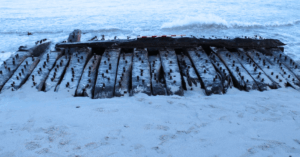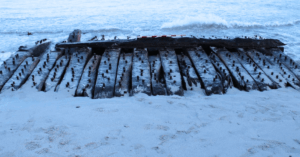
Shabab Oman II Wins ‘Best Ship’ At Tall Ships Races 2025 In Scotland
July 23, 2025
In A World First, LR2 Tankers To Be Equipped With BAR Technologies’ WindWings
July 23, 2025

A 250-year-old shipwreck found on the island of Sanday in Orkney earlier this year has now been identified as the Earl of Chatham, a ship that once served as HMS Hind in the Royal Navy before becoming a whaling vessel.
The wreck was first discovered in February 2024 by the local community after stormy weather and shifting sands exposed its remains.
Experts say climate change contributed to the discovery of the wreck, as stronger storms and unusual wind patterns moved the sands that had buried the site for centuries.
Wessex Archaeology led the effort to identify the wreck, working with Dendrochronicle and local community researchers. The project was funded by Historic Environment Scotland (HES).
The team studied the remains using dendrochronology- a method of dating wood based on tree rings, and found that the ship was built using timber from southern and southwestern England.
After confirming the origin of the wood, the archaeologists, local researchers, and members of the Sanday Heritage Centre spent several months going through old records and archives to figure out which ship it might be.
Eventually, all the evidence pointed to HMS Hind as the likely identity of the wreck, a sixth-rate Royal Navy frigate armed with 24 guns that had served in major military operations during the 1750s and 1770s, including the sieges of Louisbourg and Quebec and the American Revolutionary War.
Video Credits: Historic Environment Scotland/YouTube
When the Navy no longer needed the ship, it was sold and renamed the Earl of Chatham. It was converted into a 500-ton whaling ship, a common practice at the time as warships were built to withstand the icy Arctic waters.
As a whaler, the Earl of Chatham completed four Arctic whaling seasons before sinking in the Bay of Lopness in March 1788. At the time of the incident, 56 sailors were on board, all of whom survived.
The Sanday Heritage Group and the Orkney Archaeology Society supported the research and conservation efforts. Sanday was once known as the “cradle of shipwrecks in Scotland” due to the number of vessels that ran aground there. Despite the dangerous waters, the island’s community was also recognised for its hospitality, often helping stranded sailors.
Ben Saunders, Senior Marine Archaeologist at Wessex Archaeology, said the identification was made possible by the contributions of the local community. He said the project not only revealed details about the wreck but also gave insight into what life was like in Sanday in the 1780s.
Clive Struver, Chair of the Sanday Development Trust, said the process of identifying the wreck has been very exciting. He explained that the next step is for the community to decide how to preserve and share the story of the Earl of Chatham and Sanday’s past as a hub of shipwrecks.
The ship’s timbers are now kept in a freshwater tank at the Sanday Heritage Centre. The tank, funded by the National Heritage Memorial Fund, helps prevent the wood from drying out and crumbling.
Reference: historicenvironment
Source: Maritime Shipping News


